Category: travel
You are viewing all posts from this category, beginning with the most recent.
Galápagos Islands!!
Iguanas fighting over territory, thousands of crabs, two species of sea lions, lizards galore, birds and even a snake; this is what we saw on our first day in the Galápagos!
Today was a good practice day as we all learned about “wet landings” and “dry landings” in the Zodiacs we use to transfer from the ship to the shore. We go in groups of up to sixteen people along with a naturalist that will take us on our hike once on shore. It’s a bit of a process this first day to get off the zodiac in the water, then change shoes in the hot sand, but we are getting the hang of it.
We hiked for about 90 minutes and saw a lot of amazing animals…

When we first came ashore, we saw this baby sea lion just hanging out on the rock. Very cute.
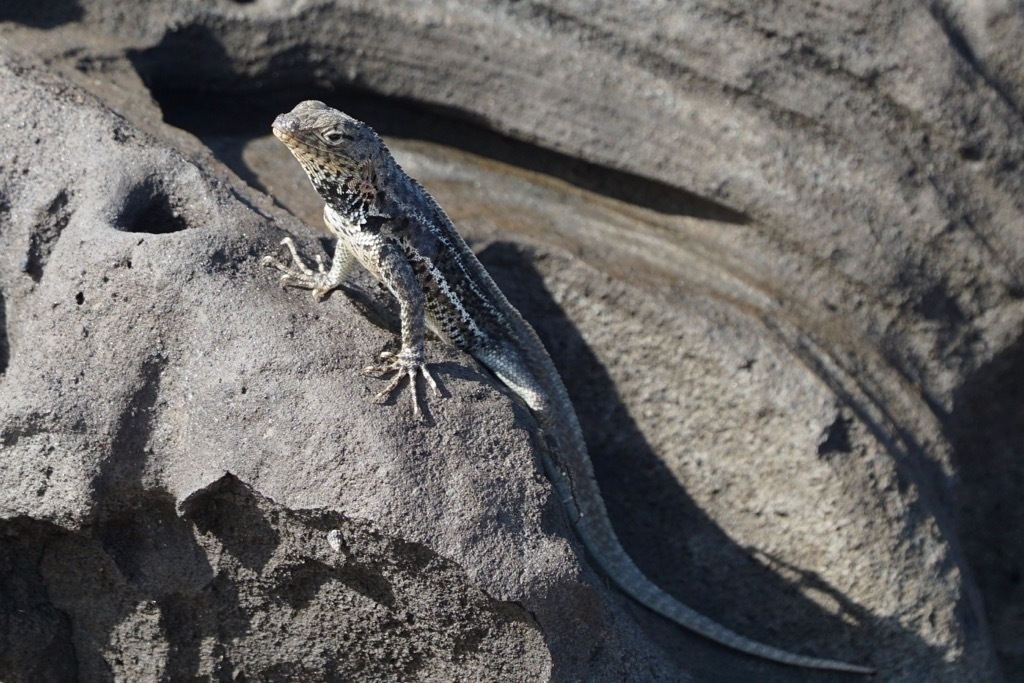
The next thing we noticed was the lizards. They were everywhere and you had to be careful as you were walking so that you didn’t step on them! They are cold blooded so at this time of the morning they were all out on the warm sand bringing up their body temperatures.

Of course the Galapagos are home to many many birds, and they have no fear of humans, very few of the animals on the islands do! But this one takes the cake as it landed on Ann’s hat. The guide told us that they really like cameras with big lenses and that they will use them like a mirror to admire themselves.

After hiking the inland part of the trail we started to walk the shoreline. Our first site was the sealions. They are nocturnal, so they were just floating in the cool waters and resting during the day. Looks like a pretty good life to me.

The shoreline was just full of these red crabs, called “sally light foot crabs”. Here you can also see one of the many iguanas looking at them. The iguanas eat algae so its not hunting them. The Oyster catcher birds, do hunt the crabs, and we saw some of those as well.

And here is the king of the iguanas! Looks like he is in charge to me!
Rabida Island

In the afternoon we headed to Rabida island for some more hiking and snorkeling. Here we are in all of our orange splendor.


The hike was hot but really beautiful.

I just loved how the prickly pear cacti just grow right out of the lava rock on this island.

This is a brackish lake. Much of the water comes from rain and runoff from the hill behind, but at high tide, some water can flow over the mangrove berm and into the lake as well.

And this is the frigate bird. They are amazing in that they steal food from other birds right out of the air! They also love to float and glide alongside and above the ship as we slowly reposition ourselves.
At the Equator
It turns out that Ecuador is a great place to study the equator. It’s not in the middle of a jungle, but runs close to Quito with lots of varying terrain. They thought that they had the equator nailed, but then along came GPS and they found out there were off by about 200 meters. Now at the new and improved site we got to explore some of the common, cool things you hear about our hemispheres.
We did the water test. Yes, when the sink is directly on the equator the water goes straight down the drain. Moving it ten feet to the south the water makes a vortex going clockwise. When you move the sink 10 feet to the north the water drains counterclockwise! This is supposed to demonstrate the Coriolis effect, but I’m skeptical (and so are lots of other folks) that the effect would really be that different just a few feet either side of the equator.
We balanced an egg on the head of a nail. It was a bit windy and tricky to get right, but in the end both Jane and I accomplished the task.
We saw the sundial telling us the “true time”. It was about 20 minutes off from my watch.
And we did a strength test. This seems to be the most controversial and unexplained of all of the equator tests we did. Standing a few feet off the equator you can resist quite well someone pulling down on your arms. But standing directly on the equator line you seem to lose all your strength. Other than psychological explanations for this I haven’t found a physics based reason for why this is true.
In the moment it doesn’t matter whether any of these things are true or not, it was a good and fun way to spend our afternoon.
Cusco Cooking!
After a morning with Chef Jose you will definitely believe that Peru is the center of the culinary universe, and has been for thousands of years. Did you know…

-
All tomatoes in the world originated in Peru?
-
All potatoes in the world originated in Peru?
-
Peru has been the top culinary destination in the world for several years running?
-
There are thousands of varieties of potatoes?
-
There are at least 3 different varieties of passion fruit?
Chef Jose picked us up at our hotel, and walked us the few blocks to his restaurant/culinary school. We started out with a fruit quiz. We actually got the first 4 of nine correct. Jose said we did way better than most.
After the quiz we tasted each of the fruits. Yes, me, I tasted all of them. Truthfully I liked most of them, except the one that looked and had the same texture as an avocado! The quiz didn’t include any banana or plantain as I had already told the chef I couldn’t eat them.

In the meantime, every few minutes someone would come in with a new appetizer for us to taste. Crunchy bruschetta and shrimp with Peruvian cheese melted on top. Delicious.
After the fruit tasting we went into the next room where we were introduced to many different ingredients used in Peruvian cooking. We learned about many different types of Quinoa, which has become so popular around the world that Peruvians have had to look for alternatives because its become so expensive in Peru!
Next up was a bit of mixology. We learned how to make the traditional Pisco Sour and another drink called a Chilcano. It was too sweet for both of us, so we decided to stick with the Pisco Sour. Which we took with us into the kitchen where we started on our first dish of the day. Ceviche — “Made with Love”. We learned not to trust any ceviche that is made and allowed to sit more than a few minutes before serving. Of course this means you need to make certain that your fish is absolutely fresh and perfect before you start.
Our ceviche was served with crunchy corn kernels and small cubes of sweet potato. Peruvian chefs love to play with combinations of flavors and textures and this combination definitely allowed for that! It was great, sweet potatoes are even tolerable if you have enough ceviche sauce on them!

After enjoying our ceviche and a little of our Pisco Sour we moved on to our second dish. A classic in Peru, called Lomo Saltado. It combines the wok cooking that influenced Peruvian chefs years ago with crunchy French fries and the rice that is so prevalent in Peruvian cooking. Like many Asian dishes this one cooks very quickly in a very hot wok once you get everything prepped.

When we finished the dish we took it outside and ate it all under an umbrella along with our Pisco Sour drinks. It was great and definitely something I’ll try to replicate back home.
This was a great culinary experience and I would highly recommend it to anyone visiting Cusco and looking to learn a bit more about Peruvian history and culture through the food!

Saqsay Waman
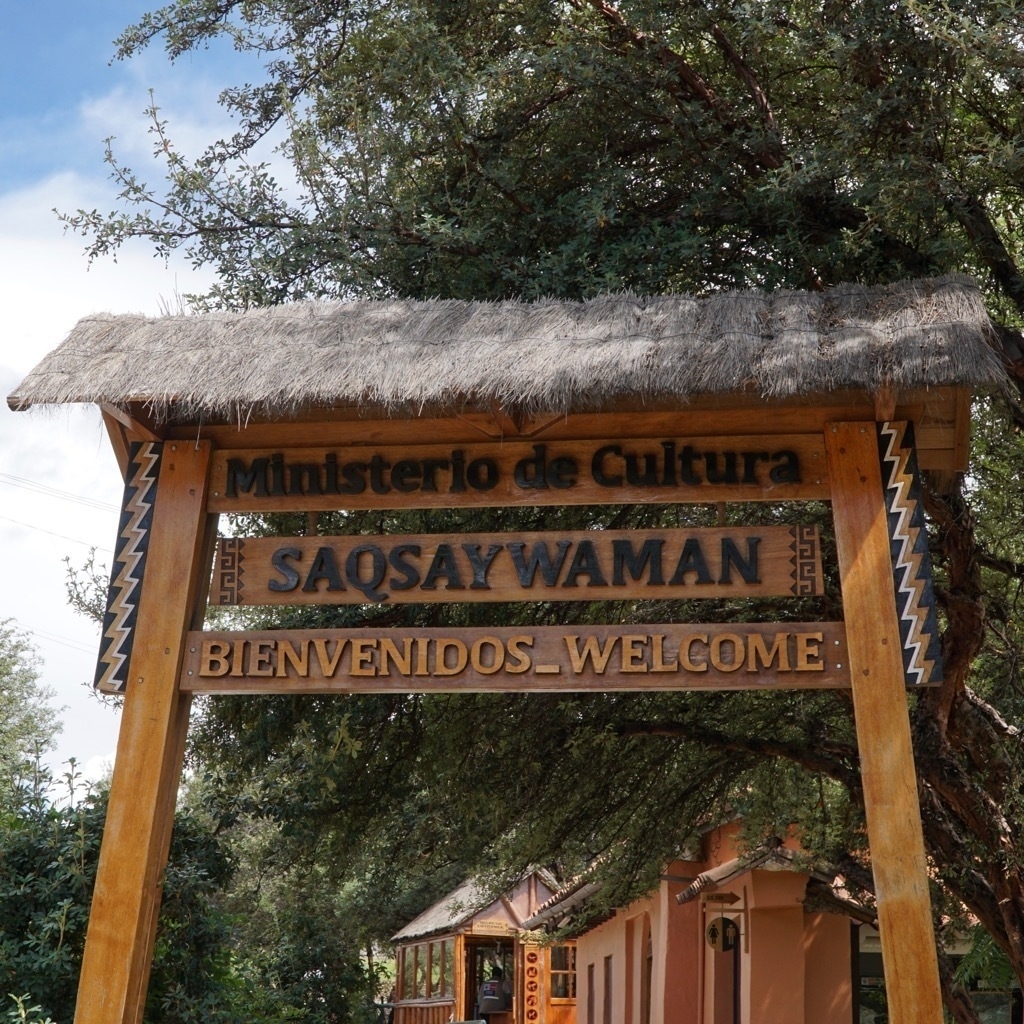
OK, if you say the above title out loud a few times you will know that I had to include that in this post. — Not getting it? Then think Sexy Woman. No, its not a risqué statue in the middle of Cusco it is another huge Incan structure on one of the many hills surrounding Cusco.

The walk around the Saqsay Waman site was also our first chance to get up close to a Llama (pronounced Yama by the locals)
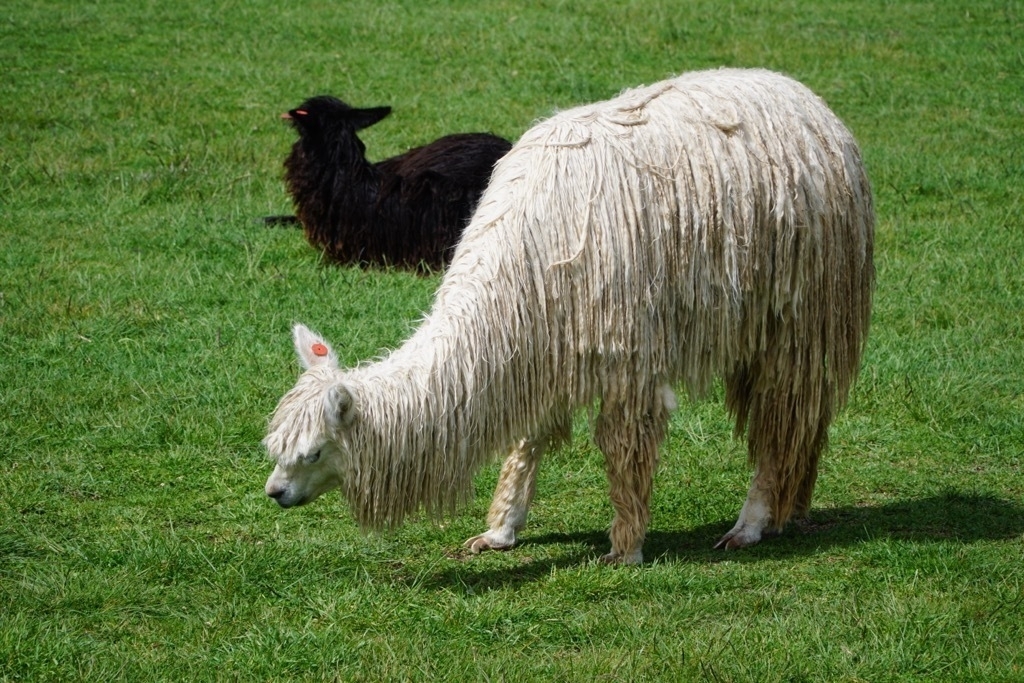
Machu Picchu
It rained hard all night long, and it was still very cloudy when we got up for breakfast. But, by the time Fernando picked us up to go to the bus, the sun was shining and it looked like we were going to have great weather for our visit.
After seeing Machu Picchu from the Sun Gate I wasn’t sure what was left. Plenty, as it turns out. It was just amazing to walk with our guide through this huge complex and marvel at the design and engineering. For everything you see above ground there is also underground engineering work to create the drainage system that has kept Machu Picchu stable all of these years.

One of the biggest threats to Machu Picchu is the number of humans that visit each year. It wasn’t designed to handle that kind of traffic!

Machu Picchu was never finished, due to the Spanish invasion, but nevertheless many people lived there over the five generations it took to get it to what we see. During that time there was even much rebuilding as priests died and new priests took their place and wanted to change or move the various temples.
You can see several different levels of workmanship. From the super high quality at some of the lower layers and in the places where the important people lived to the lesser quality near the top as they rushed to finish, or simply didn’t care to do the same quality of workmanship for the new Spanish conquerors.
After a morning of wandering around, we had a delicious lunch at the restaurant right in the national park. Then headed down to Agua Caliente where it started to pour rain again. We hung out in the market for a while then headed to the hotel, where we met up with Bob and Bonni and sat by the fire until it was time to board our train to take us back to Cusco.
You never know who you will meet on the Inca Trail
I woke up around 3:30AM when I heard a few splatters of rain against the roof of our Casita. The alarm was set to go off at 5AM, groaning internally I rolled over and listened to the rain turn from splatters to a steady stream. Our goal for the day was to do the 7.5 mile Inca Trail hike to the Sun Gate of Machu Picchu. I really was not looking forward to doing that in the rain!
After much tossing and turning 5:00 finally came and we headed up for an early breakfast. We were meeting our guide and driver at 6:00 to head to the train for the trip to our drop off point. At breakfast we met Bob and Bonni who were taking the same train, but going all the way to Agua Caliente and visiting Machu Picchu from there.
When we arrived at the lobby to meet our guide, Bonni was on the phone with their guide. It seems that there was a big accident on the way from Cusco and that their driver was going to be at last 30 minutes late, which would cause them to miss the train. We volunteered to ask our guide to see if they could ride with us rather than riding in the taxi and everything worked out great.
About halfway to the drop off point the rain stopped! By the time we were ready to hit the trail we could actually see a few patches of blue sky peeking through the clouds. This was looking like a good day for hiking after all!
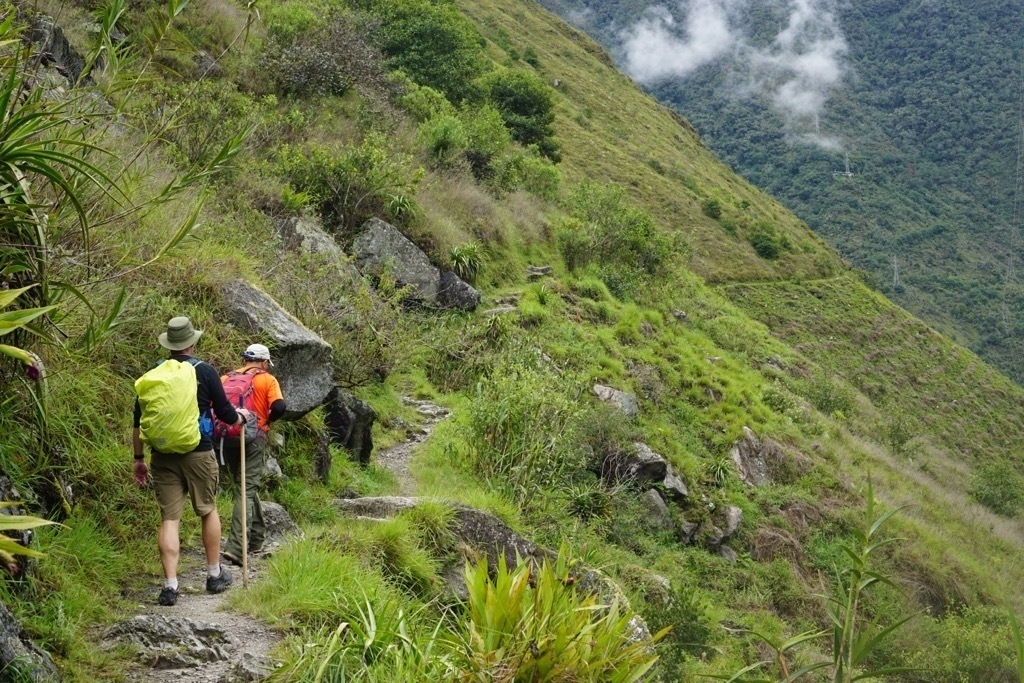
The one day hike has three main parts. The first half is up hill where we gained over 1500 feet of elevation. The next section is billed as being pretty flat, but that’s a lie. It’s flat until the end where you have to climb up to the Sun gate. From the Sun gate its all downhill, but that is maybe the last 1/8 of the 7.5 mile hike.
We took it at a good pace and enjoyed most of the climb. The scenery got better and better as we climbed higher. We were mostly alone on the trail. There was another pair of hikers that started just a bit before we did, and every so often we could catch sight of a larger group of 9 ahead of us on the trail.
Soon we were high enough to look down on the trains as they passed with passengers heading to Agua Caliente.
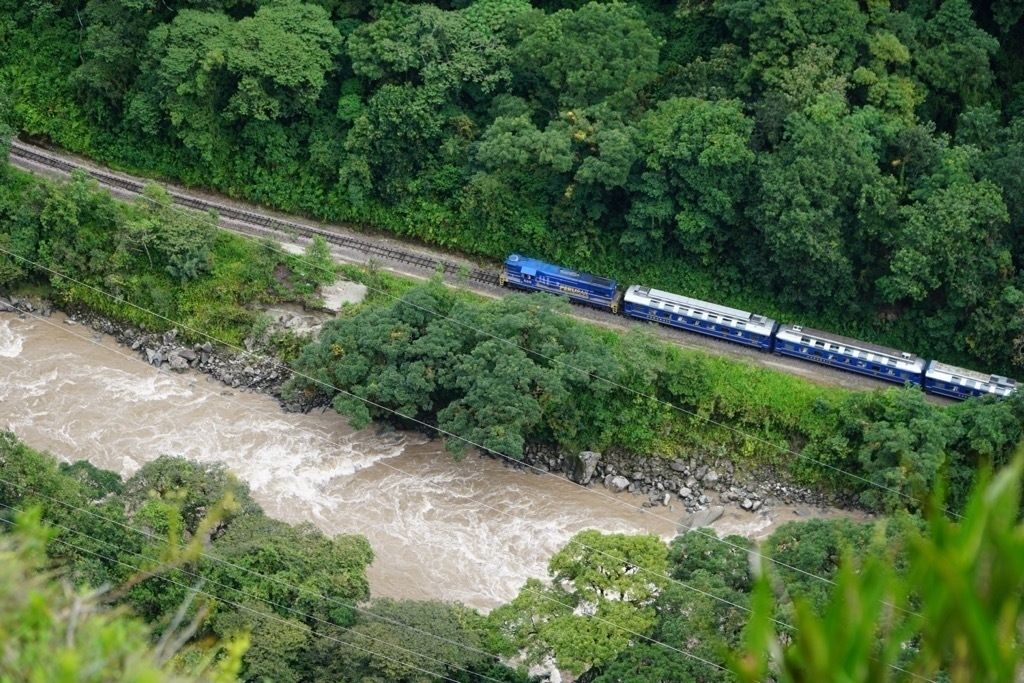
One of the sites we got to see along our hike was the amazing Wiñay Wayra terraces. It was beautiful to see from the distance.

We thought it looked close, but somehow we kept walking and it never seemed to get any closer. Finally we came down a few stairs then up a few stairs and stopped for a rest at the base of a waterfall. This was our time to gather our energy for the climb through Wiñay Wayra. When we arrived the group of nine was just leaving, so we felt like we were doing a good job of keeping the pace.
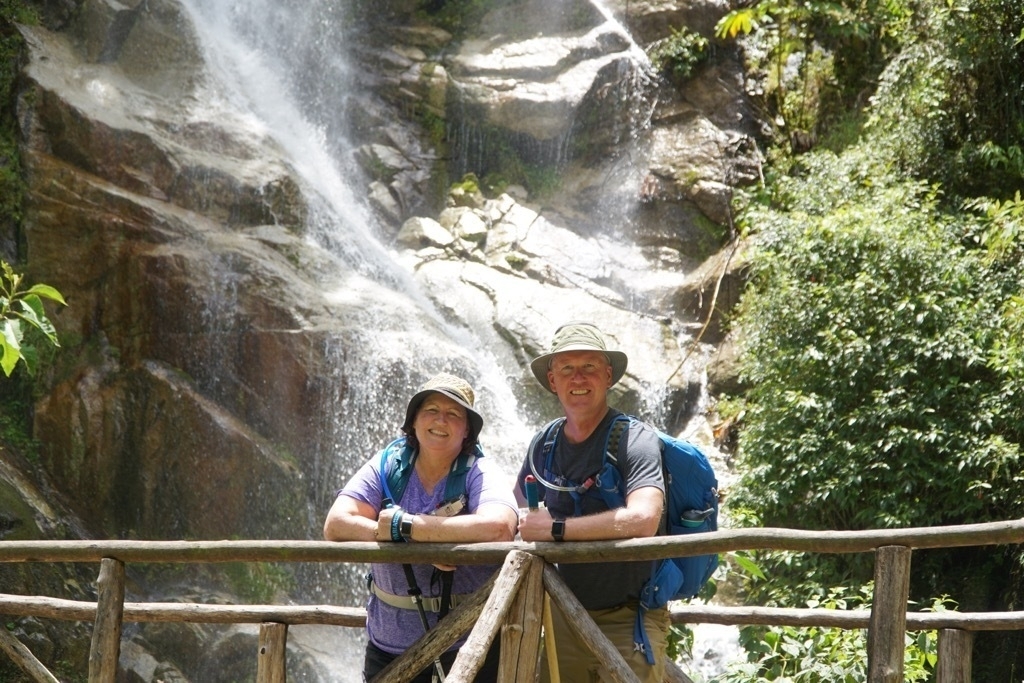
It looks a lot more daunting in person than it does in this photo. And when we finally got to the base I started counting stairs. We were able to do about 60 at a time then we would have to stop and rest and catch our breath.

The altitude definitely makes it harder work! After 375 stairs we finally arrived at the terrace about 2/3 of the way up where we were able to go across and exit. This was an amazing place for a picture.

This was basically the end of the uphill part. Both of us were extremely happy about that. The next couple of hours were pretty easy and we made good time. At some point along the way we even passed the larger group, saying our cheerful hellos as we passed.
The first big surprise of the afternoon came when I came around a corner and in the middle of the bridge ahead of me was a Spectacle Bear! It saw me and quickly headed the other direction, while I fumbled to try to unclip my camera. It moved off the path but Fernando advised us to just be quiet and wait. Soon we saw it again climbing across the limb of the tree.

Our guide had told us about the bear earlier, and we knew that it is one of two bears in the world that are vegetarian. He also said that this was only the second time in 25 years that he had seen one up close like this.
A bit further along we arrived at the first part of the trail where we started to climb toward the Sun Gate. Then we walked some more and came to the second part of the ascent, and then we arrived at the really hard part. You can get a good idea of how steep this was and a view of my best side.

We thought we would be there but we still had 10 more minutes of walking and another bunch of stairs yet! But when we finally got to the end it was so worth it! And we had the view all to ourselves.
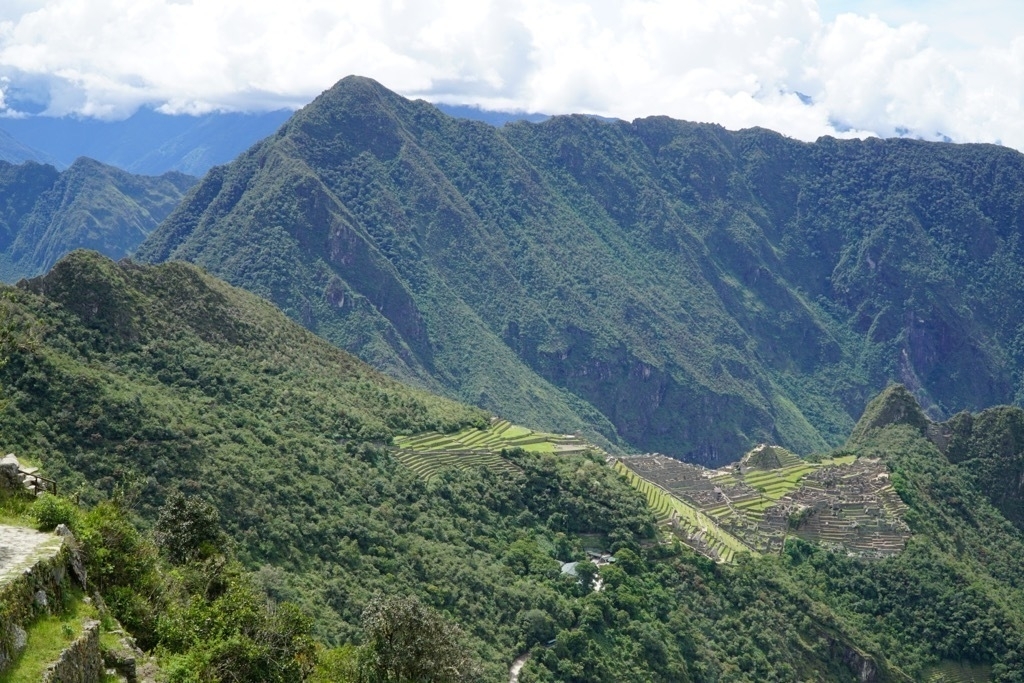
After taking in the view, we moved off to the side where we could site on a nice ledge and have a snack and continue to enjoy the view. At this point the group of nine, that we had passed at some point during the day, came through the Sun Gate as well. We exchanged greetings and discovered that the group was from Minnesota and Iowa. This led to what part of Minnesota, what part of Iowa questions etc. When I said that we had recently moved to Minneapolis from Decorah, I heard a voice say “Brad!?” And this was the second big surprise of the day. Sure enough two of the People in this group were Kurt and Paula Meyer, fellow Luther alumnus and Paula had also been chair of the board of Regents when I served as faculty representative! Amazing!! Four Luther alums on the Inca Trail arriving at the Sun Gate within minutes of each other. What are the chances? Sounds like a data science question.
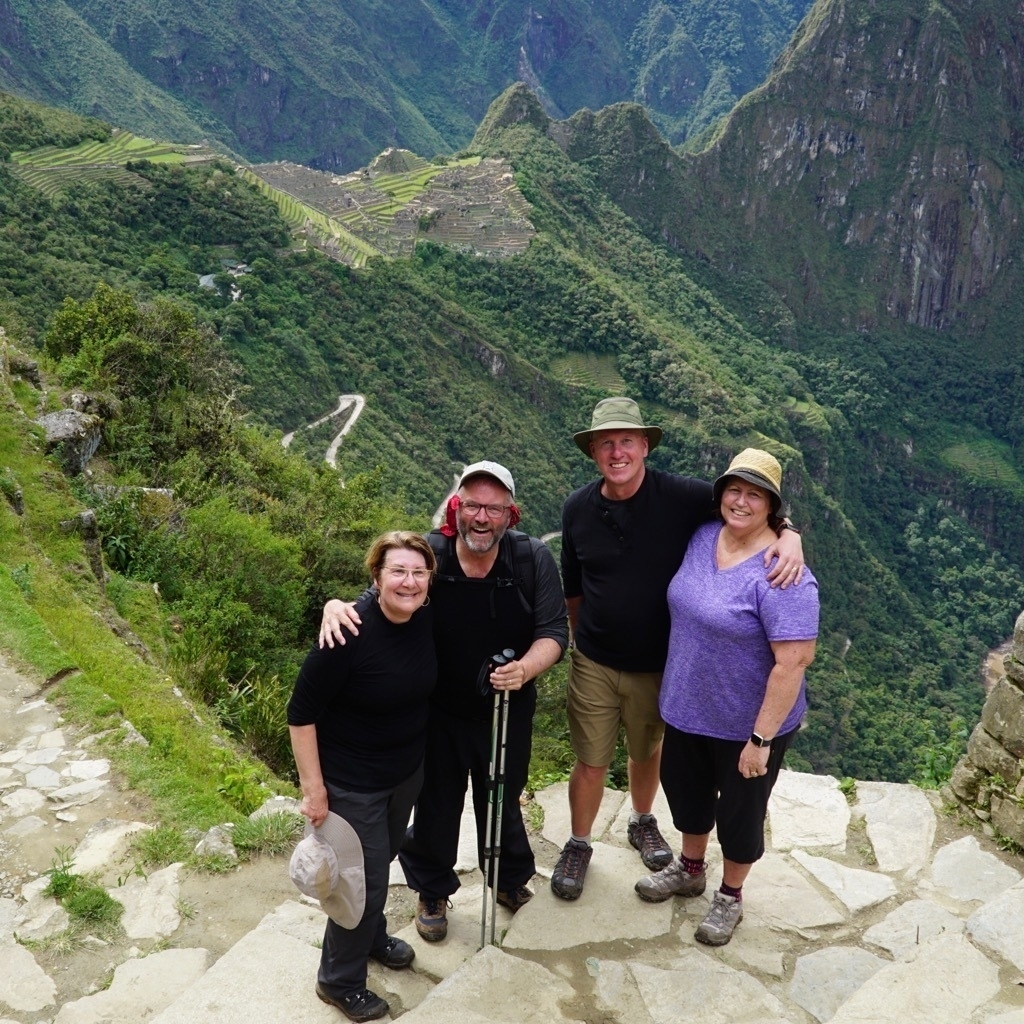
We discovered that we were staying at the same hotel that night, so we said our temporary good byes and we all headed down the final part of the trail. Along the way down we had our third big surprise. Jane was using her hiking poles and poked a viper. Our guide advised us to hurry on by and not pause to take any pictures of the poison snake. So we did.
When we arrived at the bottom we still had to take a bus further down the mountain to Agua Caliente and then a short walk to our hotel, the Inkaterra. At checkin we had the option of the 6:00 or the 8:00 seating for dinner. We thought that maybe a dip in the hot springs (Agua Caliente) would be a good way to relax and rest up for the 8:00 dinner. But by the time we had our complimentary Pisco Sour and chatted about our day with bob and Bonni, we decided that we didn’t have the energy to make it until 8:00. So we switched to the 6:00 seating and we are so glad we did. We were so tired and sore from our day of hiking that we were laying in bed reading by 8:00!
Tomorrow we go back to Machu Picchu to get an up close look!
Into the Sacred Valley
The flight from Puerto Moldenado was blissfully short. It was almost comical how many first time fliers seemed to be on our plane. When we left the runway there were gasps of joy and cheers all over the plane. There were also a lot of children making a lot of noise. Jeez I sound like some cranky old man! But we had barely leveled off before we were getting ready to land again. It was a 40 minute flight but according to Maps a 9 hour drive!
We were met by our friendly guide Fernando who will be with us for our time around Cusco. He had water waiting for us — Hydration is important at altitude as well as a nice hot cup of Coca tea. Also good for helping you get acclimated. Today we were just going to see a bit of the Sacred Valley, a local market and have a bite to eat before checking in to our hotel — Luna y Sol.
The picture below shows the spectacular view of one of the many valleys we saw. The whole base of the valley is filled with CORN FIELDS. They have a huge variety of corn, purple, yellow, red, white and other colors, and the kernels are the size of marbles. It a very important part of the local environment, and they even brew beer with it called Chicha. We have yet to try Chicha, I think it is mostly for the locals.

We did a little shopping at the local market where Jane bought a hand made silver necklace, and we enjoyed a delicious meal… It seems there is no avoiding chicken and rice in Peru. Thankfully they cook it in many different ways! We checked in to the hotel and were immediately captivated by the Jacuzzi!
Our schedule for the next day was for our guide to pick us up at the very reasonable hour of 8AM! This day we had three amazing stops. First was a textile demonstration at a women’s cooperative in Chinchero. It was fascinating to see the hand weaving and how much work goes into making blankets, and belts, and sweaters, and yes ponchos. it may not have been the smartest purchase I ever made, but if you see me wearing it around the cabin or the city you will know that I am wearing a hand made, waterproof, Alpaca poncho. Don’t worry, I didn’t buy the hat!

Our next stop was the terraces of Moray. I was not prepared for this at all!

Were they made by Aliens? What were these for? Who made them? According to our guide these were constructed by the Inca people between 1000 and 1400. Research indicates that these terraces were actually agricultural laboratories! By studying the DNA in the soil they have found that they were learning how to grow many different varieties of potatoes at different altitudes!
It blows me away sometimes to think about the knowledge that we have lost over time. When the Spanish conquered the Inca king and subdued the people and stopped their work, think of the progress and the knowledge that was lost. I’ve had this same thought in many parts of the world such as Pompeii. It makes me appreciate Google’s mission to organize the worlds information and make it universally accessible and useful. It also makes me wonder what could cause the loss of all of the information stored in the Google database? What could cause a similar collapse of a technological empire such as the world we live in today?
We learned that Inca is not really the proper term for the people, the Incas were the rulers the people were Quechua. Our guide explained that it would be like calling all of the Egyptians Pharos. I’m sure we will learn a lot more of their history when we visit Machu Picchu.
From the terraces we continued on to the Maras salt pans. Here we saw 5000 small salt pans where people make salt that comes from a salty spring. Deep in the Andes there is a giant salt deposit that this water works its way through, it then flows down this valley and through the many pans that people have created over the years to make salt. Nowadays they actually make more money from tourism than salt, but I can’t help but think that is a short term setback until some marketer comes along and makes Peruvian Pink salt the next hot commodity for home gourmets.

By the time we finished with all of this it was time for a late Peruvian lunch (2pm) which we enjoyed in the company of our guide and driver all the while just looking at the mountains that surrounded us on all sides. It really is beautiful here in the Sacred Valley!



Amazon Observations
When is a vacation not a vacation? When you are on your third day in a row getting up between 4 and 5 AM. It turns out that the animals are on a little different schedule than we humans.
Our first morning at Tambopata we had to be in the boat at 4:30 to head to the island where we were going to observe the Colorado Clay lick. We were literally up before the birds in order to watch the birds have their breakfast. It turns out that the best theory for why the birds in this area lick the clay is that it is like a vitamin supplement, providing additional sodium and other minerals in their environment that they do not get from the other stuff that they eat.
We set up our viewing point across a narrow branch of the river from the clay and settled in on our stools before the sun came up. We had a bit of coffee to keep comfortable (and awake) as we listened to mostly the silence and waited. Soon the sun started to rise and we spotted a pair of Capibaras swimming in the channel, soon the the silence was broken by a few bird calls which continued to build and build until it was a raucous cacophony of Parrot and Macaw sounds! We saw thousands of Parrots and small green Macaws, we also saw many of the large reds and the blue and greens.
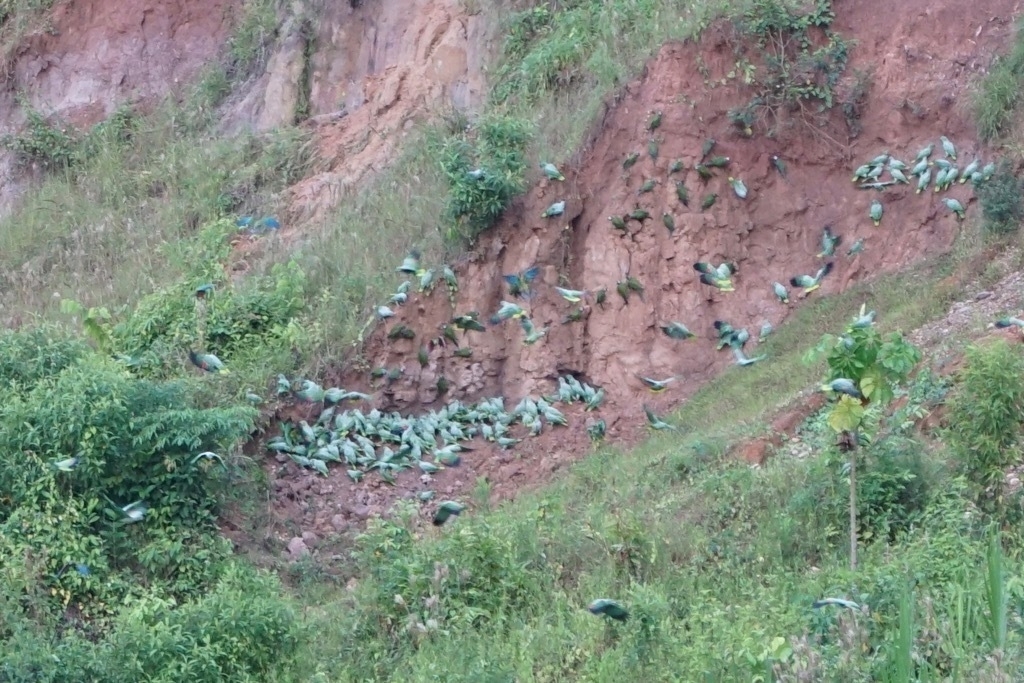
We returned from the clay lick in time for breakfast and a short break before our morning hike to the river overlook. Before we left we were lucky enough to get to watch the Macaw researchers climb the tree containing two Macaw chicks. These are part of their preservation research and so every couple of days they take the chicks out of the nest, weigh and measure them to make sure they are thriving. Macaws are not worried about the humans touching their chicks! In fact part of their research has shown that they will willingly adopt the chicks of other Macaws that are unable to care for their babies. Occasionally the Macaws will have 3 or even 4 eggs, however they are only able to forage for enough food for two chicks. So the last to be born are ignored. These researchers obtained permission to transplant these third or fourth children to nests where there is only one or even zero babies. The researcher told us about a nest that was struck by lightning and both babies were killed. After a time they moved two chicks into the care of the bereaved parents and after some initial confusion on their part the parents started to care for the new chicks.

This next image is of the parents of the baby keeping a careful watch on the researcher who climbed up to the nest.

You never know what you are going to see on one of the jungle hikes, Today we saw a lot of butterflies and Macaws and spiders, some particularly rare bird that our guide was super excited about but didn’t seem that interesting to me. It was also super hot and really humid! It was all really interesting and once we got to the river we were treated to some great views.

We decided that we were going to rest during the shorter afternoon hike and conserve our energy for the night hike.
The jungle walk in the dark was very cool. We stopped at one spot that we had walked by many times on the way to and from the river to observe a tarantula nest! Yikes! I can’t believe we walked by there all those times. I think there are millions of things in the jungle that we walk by all the time without noticing.
We also saw some pretty cool insects and even a scorpion hiding in the bark of a tree.

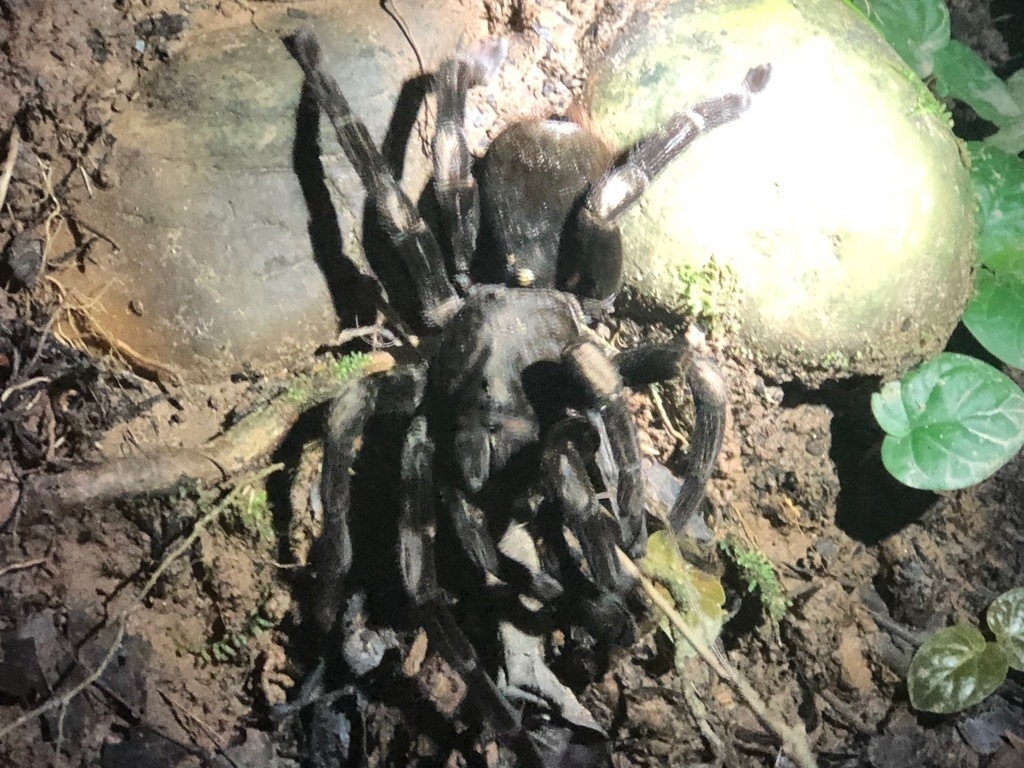
After the night hike we had to get our bags packed and outside our door so the porters could have them loaded onto the boat for our 5:15 AM departure back to civilization the next morning.
The trip back down the river went much faster than the trip up the river — we were going with the current after all. We saw a beautiful sunrise and had a very relaxing ride.

We are really glad that we made the effort to visit and appreciate this amazing part of our planet.
Fun Fact
One of these trees served as the model for the trees in the movie Avatar, the other is inspired by the trees in Avatar. I’m sure you can guess which is which? We were lucky to see both of them in the span of two months.


Into the Amazon
We walked to the light rail station which took us to MSP, from there we flew to Atlanta and onward to Lima Peru. We spent a very short night in the airport hotel, just across the street from the airport. `After five hours of sleep we had a quick breakfast and headed back across the street where we flew to Cusco and then onward to Puerto Maldonado. We were met outside the gate by our guide where we took a short transfer to the boat and a few hours later we were in the rain forrest.
It rained for most of our boat ride to the lodge, but by the time we arrived it was clearing. This meant that we could do the hike to the observation tower. A 120 foot high tower that lets you observe all the different layers of the jungle canopy, including from high above where you can see for miles!
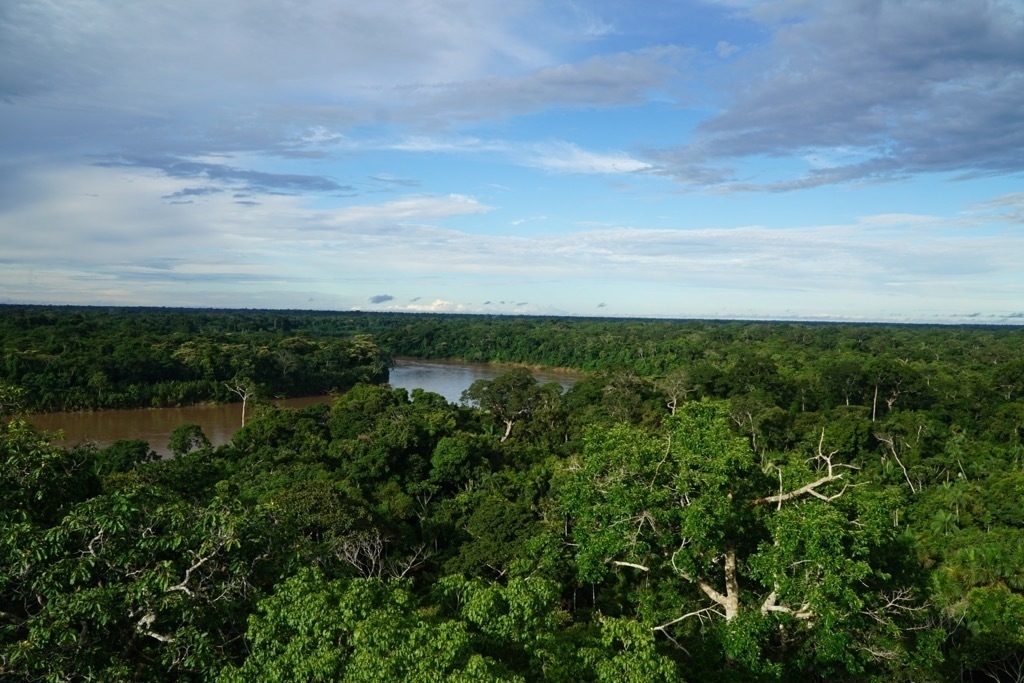
While we were enjoying our view we were joined by a clan of howler monkeys! It was amazing to watch them from above, climb through the trees and then finally up one of the support cables to the observation tower. We were a little worried they might start coming up the stairs but they kept right on moving and climbed down the wire on the other side.

We at dinner as a group, along with our guide at 7:30 and by 8:45 we were in bed. We were tired from the travel and we had a 4AM wake up for the next morning to head out to the lake and then onward for another 5 hours up the river to the Tambopata Research Center.
If you have never heard howler monkeys its really quite a thing! About 5AM we heard a sound that was just like an approaching windstorm. That is the sound that howler monkeys make in the morning to mark their territory. Incredible.
After a short boat ride we had about a 30 minute hike to the ox bow lake where we would go in search of the Anaconda (Still looking), the Caiman (a Peruvian alligator - also still looking), many birds, and do some fishing.
Well, you may be wondering what do you fish for in the Amazon? Piraña of course!

It looks a lot like a Sunfish at first glance. At least until you get a close up look at the teeth! Also, you do not typically use raw beef when fishing for Sunnies!
After our fishing excursion we were back on the river headed to our final destination for the day, which is the Tambopata Research Center. This is one of the only places in the national reserve that you can stay overnight and learn about the jungle. It is really an amazing experience.
Along the way we were keeping our eyes peeled for interesting wildlife sightings. We were richly rewarded when one of the crew spotted a Jaguar. Right out in the open sunning itself! It’s by far the best “big cat” siting we have ever had in all our travels, and I was thrilled to get some good shots.


As a final treat for the day we saw a bunch of Macaws at the “clay lick”. More on clay licking tomorrow after we learn more!

Ladder Canyon
Turn left at the arrow. Hmmm? Would you turn left and head into the rocks here? Despite the giant arrow made of rocks right in the middle of the path it is really easy to miss.

Even when you realize this is the start its a little hard to believe that this is a real trail. But it doesn’t take long before you find the first ladder and then you know you are on your way.
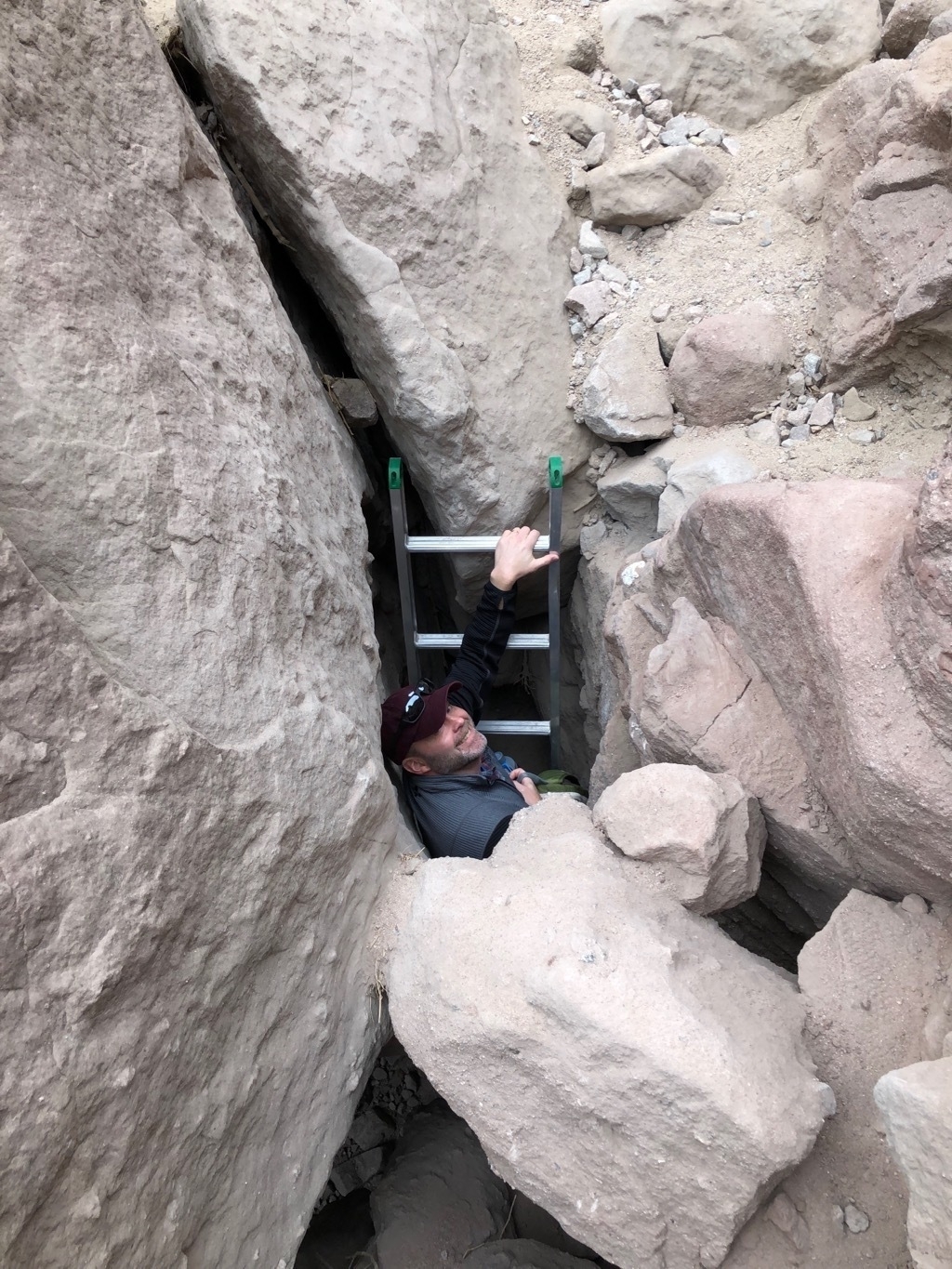
Then you get into the narrow slot canyons and you can really enjoy the hike. Even though this is not a well marked hike so you might feel a little like you are heading into the unknown.

The going is a bit slow but when you arrive at the top you are rewarded with a great view.

The way down is much wider and more open through the beautiful painted canyon. This was a great way to spend part of our last day of 2018.

I like this hiking tradition ever since we saw the #optoutside from REI a few years ago on Thanksgiving. Tomorrow we’ll continue the tradition at Joshua Tree.
Post Bike Tour Quiz
Post Bike Tour Quiz
What country would you be in if I told you the following facts?
- 90% of the people are home owners, 10% are renters and 0% are homeless
- There is no unemployment
- Possession of a firearm is a capital offense
- Possession of drugs is a capital offense
- Universal helthcare
- You cannot buy alchohol (except in a bar) between the hours of 10pm and 7am
- If you have a job lined up your are welcome
- If you are a refugee you are out of luck
- you will pay around 20% of your salary for social security and your employer will contribute another 17% but you don’t pay any income tax.
- If you want to buy an Audi plan on spending around a half million dollars
- You will not see any trash in the streets
- You can leave your bike unlocked or your purse on the table and nobody will steal it.
- Home to the world’s second busiest port
If you thought I was describing some “commie socialist dictatorship” you would be wrong. If you said Singapore, you are correct. I will admit that all of these facts come from our most excellent bike tour guide from Urban Adventures, so some of it could be “fake news” or just a simple embellishment by someone who is very proud of their country. I haven’t fact checked any of it yet. But for as much as we saw some pretty cool parts of Singapore today we heard a lot that really made us think.

Maybe the banner picture gave it away before you even read the question? The Marina Bay Sands hotel is the largest in Singapore and has some very distinctive architecture. A ship on top of the three towers, the hotel is owned by the Sands hotel in Las Vegas. It’s a massive hotel with a casino and mall and botanical gardens and a very distinctive architectural landmark of Singapore. Honestly, the Asian and Middle-Eastern architecure we have seen on this trip make America seem really boring. Hey, lets “make American architecture great again!”
One of the reasons there is no homelessness is that the government provides social housing. For as little as $30 / month for those who qualify you can rent a small 600 square foot apartment. To qualify for the next level of social housing, you have to be married and at least 21 years old in order to qualify for social housing if your job is paying less than $90,000 / year. that may seem like a lot, but it is the average income for Singapore. Once you are in at this level you can stay in for life if you want. Or you can even make improvements and sell your place for a profit later when you want to move into even more expensive private housing.
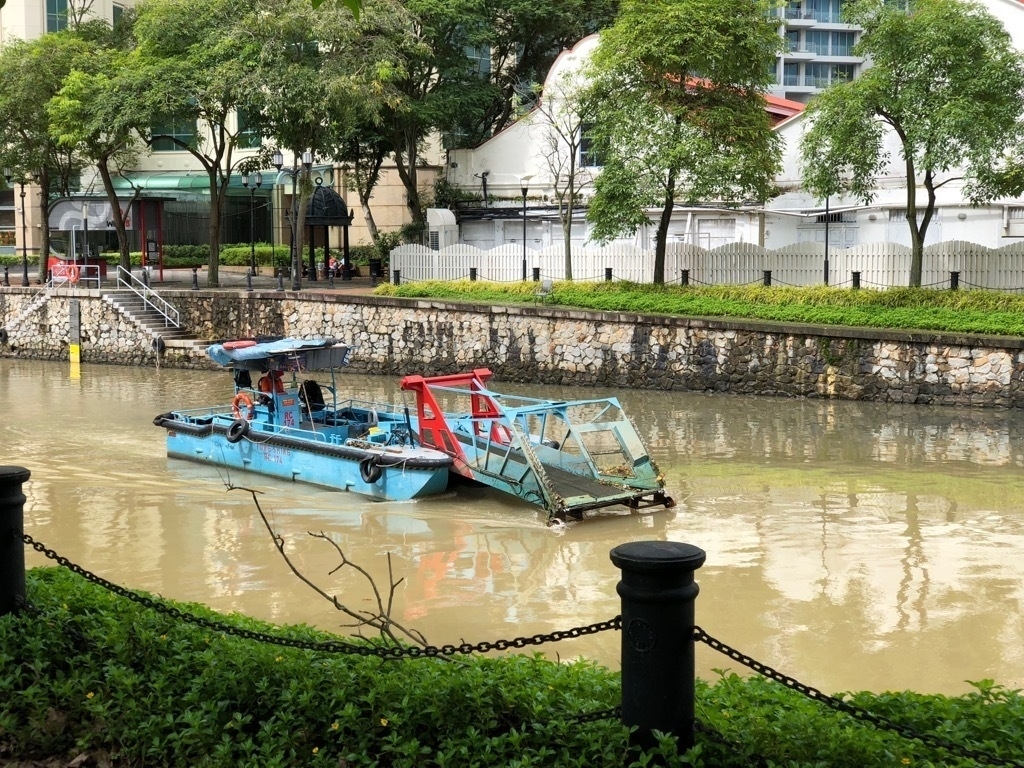
The government is run like a large multi-national corporation. The president makes 4 million a year and if you are elected you can expect to make about a million per year. Our guide put it this way, if you pay peanuts you will only get monkeys. Enough said.

Of course this is all true of a country that has a total population of around 5 million people and is only 278 square miles in size -- That is a bit smaller than New York City. It is home to the world’s second busiest port and the world’s number one airport. The government is run like a business to make money and last year they were 9 billion in the black. I think its easy for an American to look at this wistfully and say what can we learn? Why can’t we be more like this? But I think that is a pretty complicated question that brings into focus our freedoms and our history. I’d be happy to outlaw guns, but I’m not sure sure we should turn away refugees and others in search of a better life. I definitely wouldn’t want to pay half a million for my Audi! But I would support more use of mass transit and more biking in our cities.

